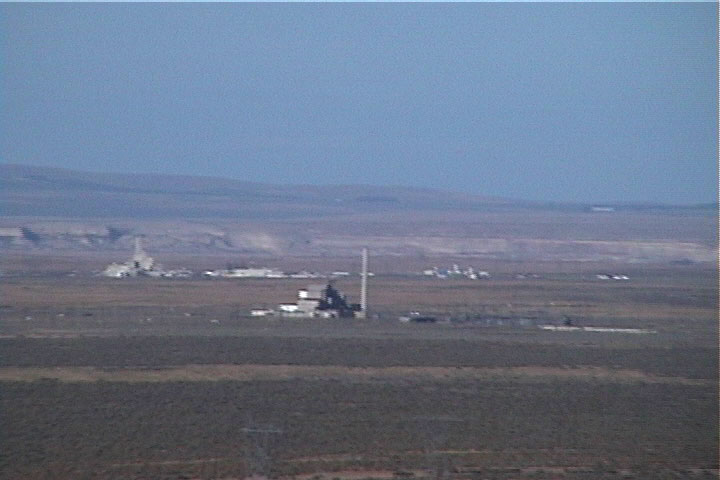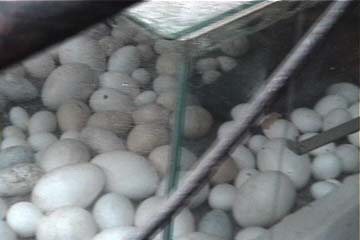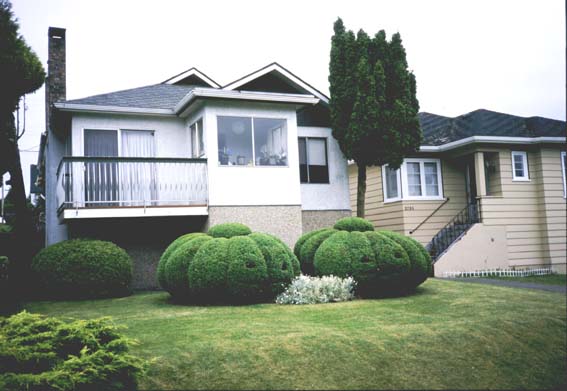When the weather is hot, the sky scintillatingly blue and the air throbs with insects, I inevitably find myself on a road trip. While on a recent drive from Vancouver, I found myself musing about the many other summer road trips I have been on. There is something exhilarating about hurtling through a vast summer landscape in a speeding car with the hot air blasting through the windows like a hair dryer and the infinite sky so intensely blue that it seems black around the edges.
I especially like to record the passing roadside landscapes with a movie camera and later hunt for images that I might have missed. A lot can happen in a thirtieth of a second.

Hanford Nuclear Reservation
Several years ago I found myself driving to Idaho via Eastern Washington to help Ruth do research on potatoes for her book, All Over Creation. I suggested we detour past the Hanford Nuclear Reservation, which has been called ‘The Chernobyl of North America, to try and get a closer look. In the distance, shimmering in the heat haze, we saw an ominous set of military gray buildings set on the arid, sage brush covered banks of the Columbia river.
The vast tawny rangeland between the highway and the nuclear reservation was ringed a security fence on which ‘do not enter’ warnings were conspicuously posted.
Since its inception in 1943, Hanford has been contaminated with “billions of gallons of radioactive waste” including plutonium, the most deadly substance known, which has been simply buried or is leaking into the ground from deteriorating metal tanks. Hanford was America’s first large-scale nuclear materials production site. The plutonium used to bomb Nagasaki was processed here and later was used to arm America’s Cold War nuclear arsenal. The people living down wind from the Hanford site, (who call themselves “the Down winders”) have sky-high rates of thyroid cancer and a resultant penchant for turtle-necked sweaters.
Ironically, this toxic Armageddon has become a wildlife paradise, supporting what National Geographic calls one of the “finest examples of shrub-steppe habitat” left in the Columbia basin. The Hanford Site is home to mule deer, elk, coyotes, badgers, rabbits, skunks, bald and golden eagles, herons, ducks, ground squirrels, several species of mice, lizards and three species of snakes.
There are also many species of rare plants. Some are endemic which is to say that they are found nowhere else in the world. A 1994 study covered only 30 percent of the Hanford Site but found 56 new populations of rare plants and discovered a completely new Lesquerella species. The 1994 study also found 205 species of birds on the Hanford Site, including 31 species of special concern, 72 species considered rare, and 9 species never before documented at the Hanford Site. Close to 1,000 insect species also were documented, including 19 species new to science and 200 species new to Washington State.
Why is there such astounding biodiversity in this toxic wasteland? It appears that for the survival of natural ecosystems, the absence of human beings more than makes up for the radioactive toxins that have been left behind by us. WE are the most powerful toxin. I riffed on this a bit in a posting on the resurgence of wildlife in the Chernobyl area, a while back. Do we need to protect endangered species by dumping radioactive wastes in their habitats to keep humanity out? That is a truly scary thought! But this is the kind of thing that creeps into my brain just before heat exhaustion sets in.
Of course there is always taxidermy. One of my most idiosyncratic pleasures on long road trips through the North American heartland, is to seek out little private museums where people exhibit their moth-eaten collections of stuffed animals and natural history curios. On the same trip, we stumbled upon one such little operation on a back road in the roasting sagebrush steppes of southern Idaho. The museum owners had some deep lava tubes caves on their property, which you could explore for a couple of dollars- well worth it as a respite from the withering heat. Upon exiting the coolness of the lava tube, we entered the run-down museum, which was full of dilapidated taxidermy, animal bones, and most endearingly, an egg collection.

Egg collection
As I understand it, poisons such as arsenic were once commonly used to preserve animal remains used for taxidermy and pose a real threat to museum curators working around them even to the present day. In fact there are taxidermists who have died of arsenic poisoning. Maybe nature is trying to tell us something.

Roadside museum taxidermy, Southeastern Idaho



